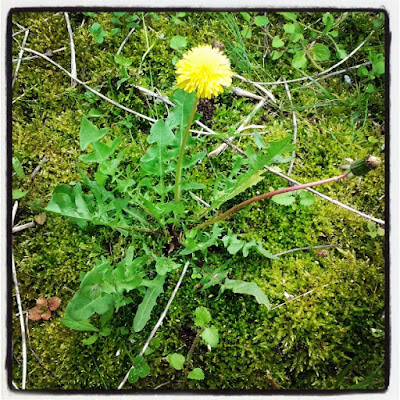WILD SPRING HERBS
Dear reader friends, on this hot day we cannot help but turn our gaze to nature which is in the midst of its spring explosion! Today we are going to discover three species of spontaneous herbs characteristic of this season and usually used in the kitchen. More generally we will talk about food plants which, in times of economic crisis, must be reconsidered! (Alimurgia stands for urgent food )
Let's start by talking about the commonly called "pisacan" or "radicéa" which went down in history with the name of Dandelion ( Taraxacum officinale Weber ). This plant is well known for its widespread diffusion in Italy where it grows in meadows and along ditches (sometimes "infesting" them!)
In the kitchen, raw dandelion leaves are used, before the flower emerges, to prepare salads. The leaves, as well as the roots, contain bitter principles (daraxacin, dandelion,...) which are useful in spring to stimulate the "purification" of the body by promoting the elimination of toxins by the excretory organs (liver, kidneys, intestine, skin). The "pisacan" has a choleretic action, stimulating the secretion of bile by the gallbladder. The aerial parts of the dandelion are also rich in mineral salts, especially potassium (in spring).
The professor. Cattorini , in the sixties, composed an ode to the dandelion which he published in his book Medicinal plants: chemistry, pharmacology and therapy. Below I report it in reduced form:
Other spontaneous plants that we see growing in meadows, along the edges of roads and ditches between March and April are the strigoli which respond to the botanical name of Silene vulgaris . In Veneto they are also called scìopetin or schioppetti due to the characteristic sound produced by compressing the flowers between the fingers. Strigoli have not entered history for their therapeutic use as they were traditionally used only as mild diuretics. In the Bel Paese, however, their culinary use is famous, widespread and varied from region to region: risottos are made with strigoli, but they can also be found fried or boiled to eat as a side dish. In Veneto they are used in omelettes which are traditionally prepared during Easter Monday or April 25th picnics.
 In this small spontaneous review of food plants, the following could be missing bruising them ? This term indicates the sprouts of Humulus lupulus that appear in spring. The etymology of the name offers interesting ideas for those who, from this reading, want to improvise as a collector: humulus derived from humeo = to be moist precisely because this plant tends to grow along ditches, perhaps hidden by the trunk of a "saez" (Willow). Lupulus instead it seems to derive from lupus salicarius (Pliny) because by twisting around the young willows it causes their death. So don't look for them in the open field!
In this small spontaneous review of food plants, the following could be missing bruising them ? This term indicates the sprouts of Humulus lupulus that appear in spring. The etymology of the name offers interesting ideas for those who, from this reading, want to improvise as a collector: humulus derived from humeo = to be moist precisely because this plant tends to grow along ditches, perhaps hidden by the trunk of a "saez" (Willow). Lupulus instead it seems to derive from lupus salicarius (Pliny) because by twisting around the young willows it causes their death. So don't look for them in the open field!
Let's start by talking about the commonly called "pisacan" or "radicéa" which went down in history with the name of Dandelion ( Taraxacum officinale Weber ). This plant is well known for its widespread diffusion in Italy where it grows in meadows and along ditches (sometimes "infesting" them!)
In the kitchen, raw dandelion leaves are used, before the flower emerges, to prepare salads. The leaves, as well as the roots, contain bitter principles (daraxacin, dandelion,...) which are useful in spring to stimulate the "purification" of the body by promoting the elimination of toxins by the excretory organs (liver, kidneys, intestine, skin). The "pisacan" has a choleretic action, stimulating the secretion of bile by the gallbladder. The aerial parts of the dandelion are also rich in mineral salts, especially potassium (in spring).
The professor. Cattorini , in the sixties, composed an ode to the dandelion which he published in his book Medicinal plants: chemistry, pharmacology and therapy. Below I report it in reduced form:
if it combines merit with modesty?
It to the hepatic, sad subject,
perhaps the concept awoke in the soul:
and - for evil - dilige et...vale!
Long live Dandelion good vegetable!
Content with the comforts that God gave her
he can be called the pariah of his species.
It grows everywhere, without pretensions,
in meadows and streets of every town.
She is persuaded and not an intruder.
Long live the Dandelion herb at home!
Heals the liver its root;
and the foliage, (so they say)
if well seasoned,
wakes up the stomach without appetite. [...]"
Other spontaneous plants that we see growing in meadows, along the edges of roads and ditches between March and April are the strigoli which respond to the botanical name of Silene vulgaris . In Veneto they are also called scìopetin or schioppetti due to the characteristic sound produced by compressing the flowers between the fingers. Strigoli have not entered history for their therapeutic use as they were traditionally used only as mild diuretics. In the Bel Paese, however, their culinary use is famous, widespread and varied from region to region: risottos are made with strigoli, but they can also be found fried or boiled to eat as a side dish. In Veneto they are used in omelettes which are traditionally prepared during Easter Monday or April 25th picnics.
As for the schioppettini , also i bruising them they offer a wide choice of use in the kitchen. Risottos, omelettes, savory pies, ravioli... do you know other uses? Then share your knowledge! Ours will benefit from it urgent food...

